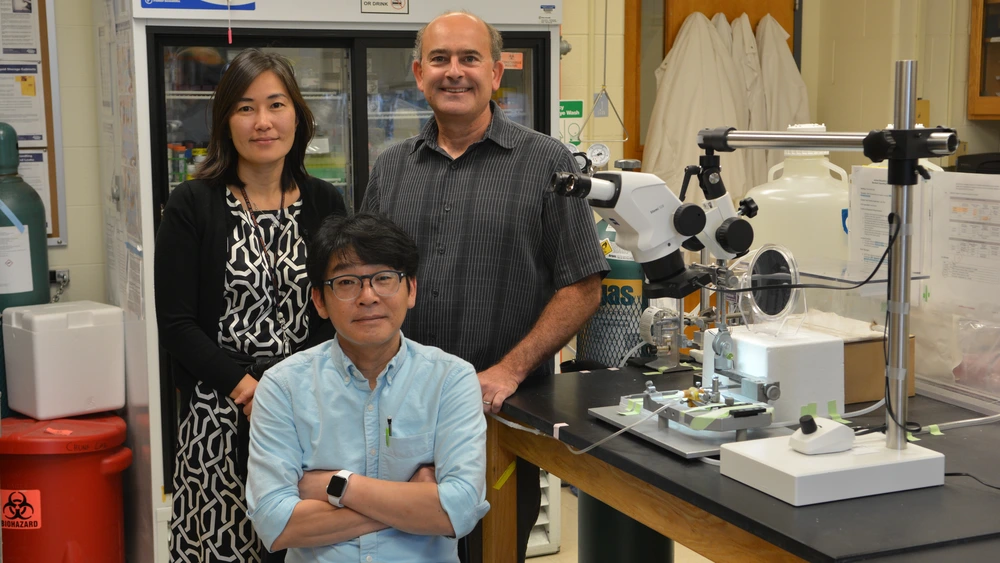
Molecular and integrative physiology professor Hee Jung Chung (left), her postdoctoral fellow Eung Chang Kim (middle), Psychology professor Justin Rhodes (right), and their colleagues discovered that heterozygous loss of KCNQ2 potassium channel gene induces autism-associated behaviors in mice including social avoidance, repetitive behaviors, and obsessive and compulsive-like behaviors.
Researchers at the University of Illinois for the first time have uncovered the contributions of KCNQ/Kv7 potassium channels in multiple behaviors including exploratory, social, repetitive, and compulsive-like behaviors.
KCNQ/Kv7 channels composed of Kv7.2 and Kv7.3 subunits open by sensing membrane depolarization and mediate outward potassium currents that potently decrease neuronal activity. De novo heterozygous mutations in KCNQ2 gene (which encodes Kv7.2) cause epileptic encephalopathy characterized by early-onset seizures that are often drug-resistant, intellectual disability, developmental delay, and autism.
“Many labs including my lab have been investigating how epileptic encephalopathy mutations affect Kv7 channel function and expression, in hopes to explain the underlying etiology. Surprisingly however, the role of Kv7.2-containing Kv7 channels in behaviors has not been described, although KCNQ2 epileptic encephalopathy accompanies behavioral comorbidities including psychomotor retardation and autism,” said Hee Jung Chung, a University of Illinois Professor of Molecular and Integrative Physiology who led this new research.
“Since pathogenic Kv7.2 mutations in patients are typically heterozygous loss-of-function mutations, we asked if there were behavioral abnormalities in KCNQ2+/- mice that were heterozygous null for the KCNQ2 gene,” said Chung.
The Chung lab confirmed that KCNQ2+/- mice display reduced Kv7.2 expression and elevated susceptibility to seizures that originate from the hippocampus. Through collaboration with Anastasios Tzingounis, a University of Connecticut Professor of Physiology and Neurobiology, the researchers showed that the hippocampus of KCNQ2+/- mice are hyperactive.
For behavioral phenotyping of KCNQ2+/- mice, the Chung lab collaborated with Dr. Justin Rhodes, a University of Illinois Professor of Psychology who has expertise in behavioral neuroscience and statistics. “My collaborator Dr. Rhodes was instrumental in this study. He generously provided behavioral apparatus to test locomotor activity and coordination and trained my postdoc Eung Chang Kim on these assays and statistics. Eung Chang was also highly qualified for these studies since he had prior experience in rodent behavior tests for social interaction and repetitive behaviors,” said Chung.
Together, these researchers first noticed that male and female KCNQ2+/- mice displayed increased locomotor activity in their home cage during the light phase compared to their wild-type littermates without grossly affecting their motor activity and coordination. No differences were detected during the dark phase when mice are most active. “These results are reminiscent of clinical reports that some autism patients experience sleep problems”, said Chung.
The researchers then discovered that KCNQ2+/- group showed repetitive grooming, social avoidance, and obsessive and compulsive-like behavior in the dark phase. “These findings are very exciting because these behaviors are the core symptoms of autism in humans. Our data suggest that reduced Kv7 current may contribute to ASD-associated behaviors in patients with de novo KCNQ2 mutation,” said Chung.
Interestingly, the researchers also found that KCNQ2+/- mice displayed enhanced exploratory behavior and social dominance with sex differences. In the first glance, these behaviors seem somewhat contrary to the well-documented reports that patients with autism experience greater anxiety than those without autism. However, multiple mouse models of autism also show reduced anxiety. “Kv7 channels regulate neuronal activity in the hippocampus and prefrontal cortex, the brain regions implicated in higher cognitive and executive functions. Therefore, our data may also reflect a decrease in the cognitive ability of KCNQ2+/- mice to recognize the potential danger of open spaces and/or perceive fear. Indeed, previous studies report that patients with autism were slower to detect and respond to both social and non-social hazards in comparison to individuals without autism,” said Chung.
This study, reported recently in the journal Genes, Brain, and Behavior, is the first to provide a tangible link between loss-of-function mutations in KCNQ/Kv7 channels and the behavioral comorbidities of KCNQ2-associated epilepsy.
As a future direction, Chung lab made the transgenic mice in which the expression of epileptic encephalopathy mutant Kv7.2 can be controlled in specific part of the brain. Tzingounis lab has provided the conditional knock-out mice for KCNQ2. “These novel mouse lines will allow us to dissect the relationship between KCNQ2 mutation and epileptic encephalopathy. Furthermore, we can use these mouse models to dissect the underlying circuitry for seizure foci and specific behavioral deficits, and explore the drugs that could correct these deficits,” said Chung. The mechanistic sights from these future collaborative studies between Chung, Rhodes, and Tzingounis will facilitate therapeutic intervention that may help the children who has this devastating epilepsy.
This study is supported by the National institute of Neurological Disorders and Stroke (NINDS) NS083402 (Chung), NINDS NS104293 (Rhodes), and NINDS NS101596, NINDS NS10887, NHLBI HL137094 (Tzingounis).
